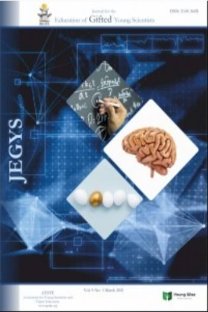Identifying Mathematics Underachieving Gifted In Classroom
Underachievement in Mathematics among gifted children has been a serious concern of most parents, teachers, school administrators and government. The first step however towards appropriate intervention in an inclusive classroom is the identification of the vulnerable children from the population. The identification of gifted child’s underachievement in Mathematics has though generated a debate which is why a position is needed urgently for classroom management. The paper thus viewed the cause of mathematics underachievement among gifted children from two perspectives: environmental and personality factors. The environmental factor stem from two problem areas; the school and the peer group. An anti-intellectual school or anti-Mathematics ability peer influence contributes greatly to mathematics underachievement. Similarly, personality factors such as Mathematics self-concept and achievement motivation are critical to mathematics achievement of gifted children. This paper therefore, revealed characteristics to observe, screening, test as well as procedure to be taken in the appropriate identification of the children who have high potential but underachieve in mathematics. It was therefore recommended that schools should adopt the procedure elucidate in this paper so as to plan for early intervention.
___
- Clark. B (2008). Optimizing Learning. The integrative education model in the classroom. Upper Saddle River, Nj: Merrill/Prentice Hall.
- Coil, C. (2004). The hidden gifted underachiever. Gifted Education Communicator, 35(4), 28-30.
- Coleman, M.R., Gallagher, J.J. & Foster, A. (1994). Updated report on state policies related to the identification of gifted children. Chapel Bill: University of North Carolina.
- Dada, O. A. & Akpan, S.M. (2019). Discriminant analysis of psycho-social predictors of mathematics achievement of gifted children in Nigeria. Journal for the Education of Gifted Young Scientist, 7(3), 647-655
- Dada, O.A. & Dada, E.O. (2014). Efficacy of co-operative and self-directed learning strategies in enhancing mathematics achievement of underachieving gifted students in Nigeria. IORS Journal of Humanities 1and Social Science 19(9) 41-50
- Dada, O.A. & Fagbemi, O.O. (2018). Influence of Emotional Intelligence and Locus of Control on Academic Achievement of Underachieving High Ability Students. Journal for the Education of Gifted Young Scientists, 6(2), 14-22
- Dada, O. A. & Ogundare, O. G. (2017). Paradigm shift in assessment for giftedness and talent: A catholicon for realistic gifted education in Nigeria. African Journal of Theory and Practice of Educational Assessment 3, 10-21
- Davis, G.A., & Rimm, S.B (2004). Education of the gifted and talented (5th ed). Needham Heights, MA: Allyn and Bacon.
- Deliesle, J. (2004). Comfortably numb: A new view of underachievement Gifted Education Communicator, 35(4), 17-20.
- Feuerstein, R. (1978). Learning potential assessment device. Baltmore, MD: University Park Press.
- Frey, R. (1989). Giftedness and underachievement. Gifted education. Press newsletter, 3(1), 3-4
- Hunt, J. G. & Kirt, J. (1971). Social aspect of intelligence. Evidence and issues in R Cancro (ed), intelligence. Genetic and environmental influence. New York, Ginnen & stralton.
- Janos, P. M. & Robinson, N. M. (1985). Psychosocial development in intellectual gifted children in E Herowitz & M.O Brien (eds). The Gifted and Talented. Development perspectives (p 149 – 195) Washington, DC. American Psychological Association.
- Kames, F. A. & Pearce, N. (1981). Governors honours programs. A viable alternative for the gifted and talented. Gifted Child Quarterly,, 18, 8 – 11.
- Laffoon, K. S., Jenkins-Friedman, R., & Tollefson, N. (1989). Casual attributions of underachieving gifted and non-gifted children. Journal for the education of the gifted, 13(1), 4 – 21 McCoach, D.B & Seigle, D. (2003). Factors that differentiate underachieving gifted children from high achieving gifted children. Gifted Child Quarterly, 47(2), 144-154.
- Pegnato, C., & Birch, J. (1959). Locating gifted children in junior high school: A comparison of methods. Exceptional Children, 25, 300-204.
- Redding, K. (1990). Learning preferences and skills patterns among underachieving gifted adolescents. Gifted Child Quarterly. 34(2), 72 – 75.
- Rimm, S.B. (1986). Underachievement Syndrome. Causes and cures. Watertoon, WI. Apple
- Seeley, K.R (1993). Gifted children at risk. In L.K.Silverman (Ed.). counseling the gifted and talented (pp. 263-276). Denver, CO: Love.
- Smith, S., Dean, S., Kaplan, S., Phelan, P., Russell, S., & Spelman, C. (1990). Assessing and Identifying children for gifted and talented program: Recommended procedures.
- Sternberg, R. (1981). A componential theory of intellectual giftedness. Gifted Child Quarterly, 25(2) 86 – 93
- Sternberg, R. (1985). Beyond IQ: A triarchic theory of human intelligence. Cambridge. MA: Cambridge University Press.
- Van Tassel-Barka, J. (2000). The talent development and What we know. Paper presented at the Utah Association for the Gifted Midwinter Conference, Salt Lake City. UT
- Whitmore, J. (1980). Giftedness, conflict and underachievement. Boston, Allyn & Bacon.
- Başlangıç: 2013
- Yayıncı: Genç Bilge Yayıncılık
Sayıdaki Diğer Makaleler
Elaheh RAHİMİNİA, Shahram YAZDANİ, Hoorieh RAHİMİNİA
Mohammad ZAHRİ, İ Ketut BUDAYASA, Agung LUKİTO
Kgaogelo Johanna MASEMENE, Sıkhulıle Bongınkosı MSEZANE
Maya ISDİANTİ, Harun NASRUDİN, Erman ERMAN
Poppy YANİAWATİ, Jasem AL-TAMMAR, In In SUPİANTİ, Siti Zuraidah MD OSMAN, Acep SAEFUL MALİK
